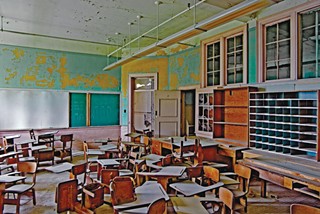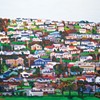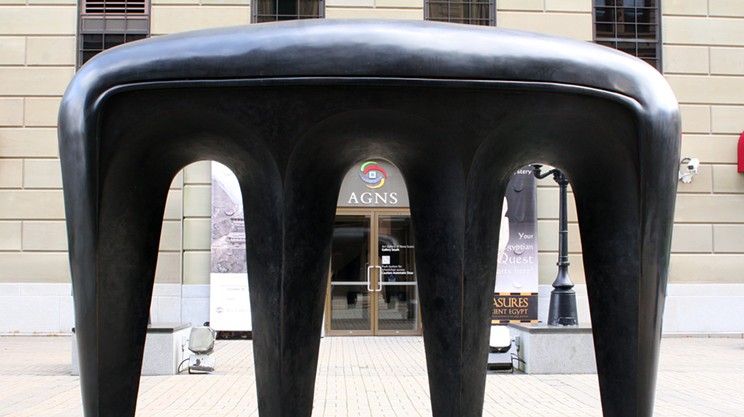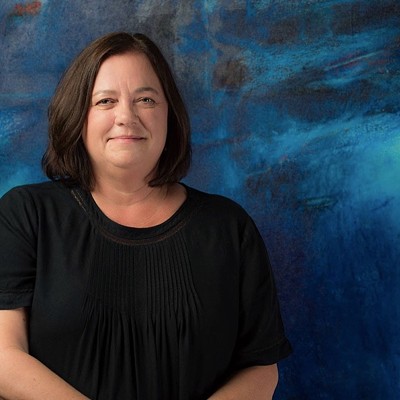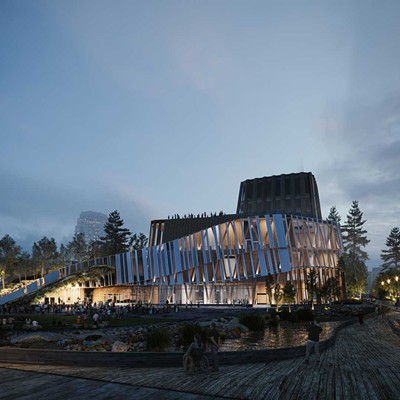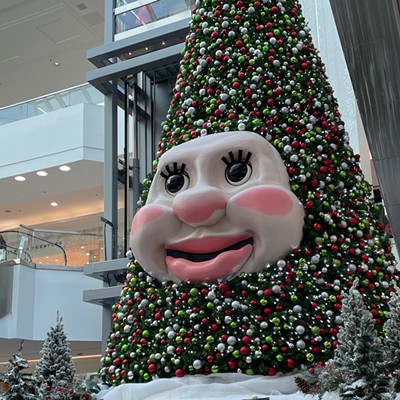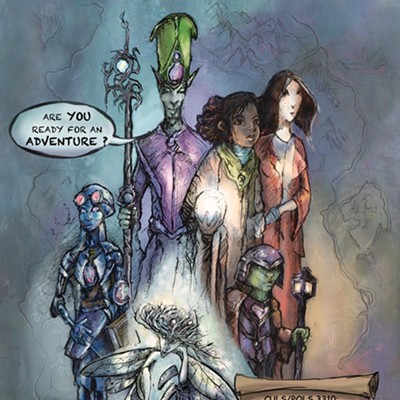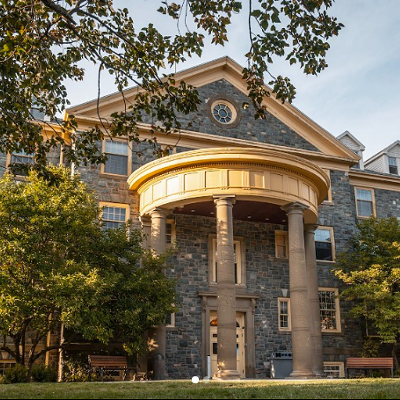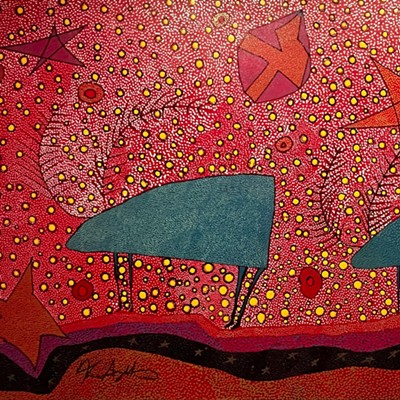Will Gorlitz: nowhere if not here
Through August 23
Guelph-based artist Will Gorlitz begins a painting by looking for the telling detail. "When determining the actual subjects I wish to paint, a crucial consideration is that the subjects present some acutely visual feature," he explains in an email. "Commonly, this involves the tactile materiality of substances or some fleeting perceptual conditions," he continues. This is evident in, for example, his paintings of rural roads in winter, especially one where the salt fills cracks in the pavement; no doubt the result of long, close and cold moments of observation. In "Grassfire," he creates a strong sensory experience and triggers a clear memory of what it feels like, the fascination to fear, to witness a fire's transformation. In another series, leaves float on water, but the artist subtly arranges them into numbers, in the same way we impose sequences or patterns on nature as we experience it, or as we remember it afterwards.
Piles of Birds: The Folk Art of Barry Colpitts
June 24-July 26
Barry Colpitts is a wood carver from West Jeddore on the eastern shore. This summer he mounts Piles of Birds at the Craig Gallery, part of Alderney Landing, which celebrates its 10th anniversary this year. The exhibition consists of eight new pieces, including a full-sized throne made of seagulls, leaving little doubt of folk art's connection to the grotesque, or the gothic for that matter. Wood carving, arguably more than any other folk medium, displays those two traditions' physical distortions, humour and fantastical forces at play. There's a sense of funhouse spookiness, akin to episodes of The Hilarious House of Frankenstein or The Simpsons' "Treehouse of Horror" episodes. Colpitts' work is also featured at the Nova Scotia Folk Art Festival in Lunenburg (Lunenburg Arena, August 2, noon to 4pm) and on the festival poster. During the exhibition's run, Colpitts will work on the Dartmouth waterfront, call ahead for times.
Angela Carlsen: No Vacancy: A disappearing history
July 1-August 2
Angela Carlsen appreciates abandoned structures. She's documented unoccupied, neglected houses. Now, she's turned her lens on public buildings, including Greenvale School, Shannon Park and the recently vacated Halifax Herald building. "It feels exciting and depressing at the same time," she says of the impact shooting at these sites has on her. "I definitely feel overwhelmed and don't know where to start, but I try to take in an entire room and then dissect it with my camera." Carlsen looks for "lines, depth and shape and I try to make a photograph that has symmetry but also says something about the place." Though absent of people, their presence in and around these buildings is implied. While she continues to deliberate on her own position on heritage conversation, she applauds the refurbishment and reuse of Greenvale School, "a beautiful old brick school [where the] interior is being gutted and the facade kept intact."
Kent Monkman: The Triumph of mischief
August 29-October 4
Kent Monkman's work has wide scope. He's a multimedia artist (painting, performance, film/video and installation) and his exhibition is coming to Halifax this summer. In The Triumph of Mischief, which in name alone sends up the heroic in history, he re-imagines the imagery, motifs and stories of first contact, or simply contact, between First Nations peoples and European settlers. Monkman, a Cree artist, takes a "Queer perspective," according to SMU Art Gallery information, on this major historical narrative in Canada. He questions stereotypical figures and representations (of manhood, good and bad). The romanticized landscape of Canada, as vast, empty and undiscovered frontier, becomes the basis for Monkman's recreation in the 19th-century Beaux-Arts style of landscape paintings, which hang in galleries across the country. A silent film plays in a reinvented teepee and Monkman dresses in drag as Miss Chief Share Eagle Testickle. What a way to close the summer season.
Susan Bozic: The Dating Portfolio
July 18-October 4
It's said you can tell when two people are really and truly in love by the way they look at each other. Vancouver-based photographer Susan Bozic satirizes the look and existence of true love, as it's popularly understood, in her series The Dating Portfolio. She stages scenes from a perfect relationship, casting herself (like Cindy Sherman) as the perfectly content girlfriend to Carl. He's good-looking, statuesque, but a bit stiff---Carl's a mannequin. "The humour presented in this work is the first stage in reading the images and is intended to draw the viewer in," says Bozic in an email. "The longer you look, the more psychologically complex they become." The artist frames love as just another product packaged and marketed for mass consumption. "We're constantly being sold on the ideal, whether it's projected onto people or things. The romanticized images in The Dating Portfolio are a surrender to those ideals."
invocation: Sculpture in Stone and Whalebone, Wood and Clay by Linda Johns
July 24-September 6
In this retrospective of Linda Johns's sculptures, guest curator Jeffrey Parker gathers some 35 works together. Looking back at these objects, one appreciates, for a start, the diversity of the material used and the shifts Johns makes from one to another. "Bone and wood are nearly the same process, but the tools differ," explains Johns. "Clay is an additive process, so you build your object rather than carve away what you don't want. These are two entirely different ways of seeing." Johns senses the form to invoke, while also forming a plan for her approach in the studio. "Both processes are at work simultaneously, especially with wood and bone because their inherent free form shape evokes a natural expression. I (turn the piece) over and over to see and feel its energy and what it has to say."
Jack Bishop: Survey of works
June 26-July 10
While survey exhibitions are usually associated with older, established artists, this show surveys work from mainly the last two years by young New Brunswick painter and NSCAD graduate Jack Bishop.
"The idea is to show the relationships between the different series of paintings I've made: cars, shoppers and houses," notes Bishop. "Despite subject matter, a lot of the technical parts of my paintings blend into each other, like the use of repetition, distortions of space and different formulas I've used to piece them together through drawing, tracing, photography or collage."
For his houses and subdivisions, he's used both collaged magazines and photomontage for his foundation. Thematically, Bishop's different series together survey what he calls "social consumerism." The viewer can see how that activity creates and mediates landscapes and land use. "I tend to paint in a serial manner, taking an idea and making different variations, and then going back and re-trying things that worked in other paintings."
Sound and Kinetic Dimensions Class Exhibition
August 3-9
Halifax has its medical school and teaching hospitals. The city also has its art college, or, officially, its visual arts university, with its own network of teaching galleries, including the more recently established Seeds and Port Loggia and the oldest and original, the Anna Leonowens Gallery. NSCAD continues to bring in leading contemporary artists, such as Montreal-based Jean-Pierre Gauthier, to teach and to organize class exhibitions at the Leonowens. Gauthier's moving (in both physical and imaginative senses of the word) installations won him the Sobey Art Award in 2004. This summer he guides students from conception to exhibition of their sound and kinetic works. This art-making crosses boundaries, offering not only an object to consider but also the material or mechanisms used for its animation. To compare with, and to prepare for, Gauthier's class show, you could check out Sometimes Always, presented by Centre for Art Tapes at the AGNS (on now until August 30).
Nomi Chi
August 8
An illustrator, painter and tattoo artist, Nomi Chi says that shifting gears from art to tattooing, from paper to people, “can be a bit of a daunting task.” Her work suggests she’s up to it. (See it at nomi-chi.com.) No matter the medium, her style is consistent: fluid forms, weighted and curving lines and exploratory colours (turquoises, bright blues, dry and wet reds, clay-gray). Chi’s human and animal figures wear wounds and marks of decay, but they’re still very much alive and powerful. “My interest in animals, dissections, et cetera, is rooted in my childhood and an early interest in biology,” she explains. “I lived in Ontario when I was younger, and spent a lot of time outdoors hiking with my dad and studying nature.” Though she’s not spiritual---“not even a little bit”---Chi is “passionate” about science and describes herself as “a very conflicted person and I’m pretty sure that’s why my art is the way it is.”

